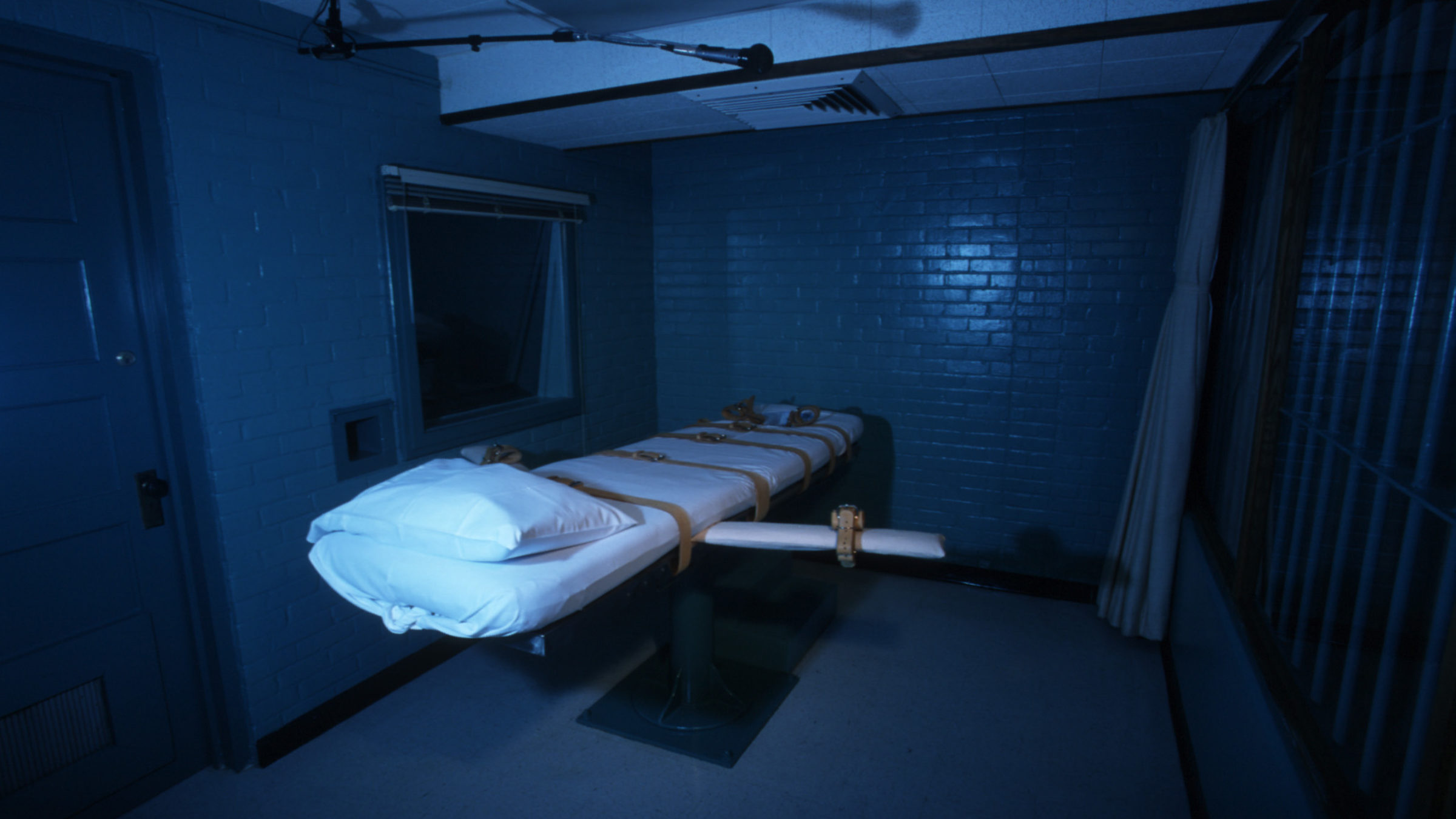Arkansas uses three drugs to kill people on death row. First, midazolam, a sedative sometimes used in surgery to decrease anxiety before a procedure, or help anesthetize a patient. In executions, it’s used to make the person unconscious before prison officials administer the other two drugs: one that paralyzes, and another that stops the heart. If the person is still responsive after the initial dose of midazolam, officials give them more until, theoretically, they no longer respond to any stimuli.
In Johnson v. Hutchison, which the Eighth Circuit Court of Appeals decided last month, three individuals on death row sued the state, arguing that this three-drug cocktail violates the Eighth Amendment’s ban on cruel and unusual punishment. The problem is that midazolam may have a ceiling—a dosage past which it doesn’t render people “insensate,” or unaware of what is happening to them and unable to respond to stimuli. In other words, a person who reaches the midazolam ceiling would be conscious for the entirety of their execution.
In a different case concerning the use of midazolam, a magistrate judge in Ohio found, after hearing extensive expert testimony, that “midazolam at any dosage level has no analgesic properties,” and cannot stop the person from being aware of the pain caused by the second and third drugs. The magistrate also found that the high doses of midazolam used in executions can cause pulmonary edema, an observation borne out by the fact that autopsies of 24 of 28 people killed with a protocol that uses midazolam had frothy, bloody fluid in their lungs. One expert testified those not sufficiently affected by midazolam would experience “a sense of drowning and the attendant panic and terror, much as would occur with the torture tactic known as waterboarding.”

The death chamber in Huntsville, Texas (Photo by Joe Raedle/Newsmakers)
In Johnson, the Arkansas plaintiffs marshaled evidence similar to that in the Ohio case. Among the studies they included is one showing that 72 percent of participants could still respond to verbal commands after a typical dose of midazolam.
In its opinion, the district court conceded the existence of a ceiling effect, but said that since there is no medical consensus about where the ceiling is, Arkansas’s use of the three-drug protocol is constitutional. When the case went before a three-judge panel on the Eighth Circuit, Judges Steven Colloton and Jonathan Kobes—a George W. Bush appointee and a Trump appointee, respectively—agreed, reasoning that the plaintiffs’ study of midazolam involved giving far less of the drug to participants than Arkansas gives to people on death row.
A court that gave a shit about the Eighth Amendment’s promise might decide that until judges can get more information about whether the execution process subjects conscious people to excruciating pain, executions should stop. Finding a “paucity of reliable scientific evidence concerning the effect of large doses of midazolam on humans,” however, the Eight Circuit panel concluded that Arkansas can go ahead and keep killing people with no constitutional concerns.
Worse still, people on death row in the Eighth Circuit will likely never be able to prove the existence of a “scientific consensus.” Doing so would require plaintiffs to show that scientists are very certain about what happens when the state injects people with drugs designed to kill them. But there will never be a study that examines whether there is a ceiling at the massive 500mg dose people are given in the death chamber, because there are obvious ethical issues with pumping people full of midazolam and then seeing if they feel the pain of their heart being stopped. (Even one of the state’s experts acknowledged these hurdles, noting in a wild understatement that “volunteers would take a long time to wake up.”) One of the plaintiff’s studies, for example, administered just 20mg of midazolam, plus an additional 15mg each hour, to a 220-pound man. The “scientific consensus” standard requires plaintiffs to come up with evidence that will never exist.
This cruel jurisprudential quirk is the product of the Eighth Circuit’s embrace of Justice Samuel Alito’s concurrence in Baze v. Rees, in which he, and he alone, argued that establishing a “scientific consensus” is necessary in lawsuits that challenge methods of execution. No other appeals court has latched onto this language, but the Eight Circuit has run with it. As noted by Judge Jane Kelly, an Obama appointee who wrote separately in Johnson, this standard “is not required under Supreme Court precedent,” and is a “nearly impossible standard for prisoners to meet.”
For conservative judges, this concern for the existence of a scientific consensus prior to judicial intervention evaporates when it comes to abortion access. Unlike the science of midazolam uptake, the science of abortion is well-settled. Fetal viability—the point at which a fetus can live outside the womb—is at best 23 or 24 weeks. A fetus can experience pain shortly thereafter, at 24 or 25 weeks. The mortality rate for pregnancies is 8.8 deaths per 100,000 live births. The Centers for Disease Control has found that the death rate per 100,000 legal abortions is fewer than one, and that even calculating it is difficult because the number of deaths from legal abortions is “small and statistically unstable.”
Anti-choice laws rely upon making legislative “findings” that gleefully ignore facts like these. Mississippi lawmakers who passed their state’s 15-week abortion ban, for example, “found” that second-trimester abortions are more dangerous than pregnancy, which is simply not the case. At the district court level, they even conceded that a fetus at 15 weeks is not viable. So-called “heartbeat bans,” which purport to prohibit abortions after ultrasound machines detect cardiac activity, are also based on junk science. What legislators call a beating heart is electrical activity caused by the ultrasound machine. Among the reasons that sound cannot be a beating heart is that a six-week-old fetus has not yet developed heart valves.

When you’re not a doctor but HAVE watched a lot of Grey’s Anatomy (Photo by Chip Somodevilla/Getty Images)
Alito’s opinion in Dobbs v. Jackson Women’s Health Organization doesn’t talk about scientific consensus, or science really, at all. Instead, it relies on the legislature’s “factual findings” that at 12 weeks, an “unborn human being” has “taken on ‘the human form.’” This language, which is just the Mississippi legislature quoting Justice Anthony Kennedy’s opinion in Gonzales v. Carhart, is scientifically meaningless.
The rest of Dobbs’s reasoning is just as empty. Alito tells us, for example, that “when prospective parents who want to have a child view a sonogram, they typically have no doubt that what they see is their daughter or son.” This isn’t science, and it certainly isn’t “legal reasoning” in any sense of the phrase. It’s just Sam Alito throwing everything at the wall and not even caring if it sticks, because the Court’s conservatives have a six-justice supermajority and can say whatever they want.
Judges, of course, are not scientists or medical professionals. But their willingness to be very bad at amateur doctoring leads to results as capricious as they are cruel. When confronted with the scientific consensus around abortion care, courts can ignore it. When confronted with the tiniest shred of doubt about the extent to which execution is tantamount to state-sanctioned waterboarding, courts can throw up their hands and look the other way. Conservative judges care deeply about science, until doing so becomes personally and professionally inconvenient.




